 Author: Daniel Li, CoinVoice
Author: Daniel Li, CoinVoice
The bull market that has lasted for more than two months has made investors more enthusiastic about searching for potential value opportunities in the market, and has also provided some well-established projects with the opportunity for a new lease on life. Ronin Network, as an old public chain established in 2021 and experienced the baptism of the bear market, has ushered in a new beginning in early 2024 after a year of continuous efforts in 2023.
According to BlockBeats data, the number of active addresses on the Ronin Network has increased by 3225% in the past three months. The highest number reached 693,000 on January 25, and the price of its token Ron has also increased by over 800% in the past three months, currently priced at $3.18. So, what exactly is Ronin Network? Why is it so sought after by investors? As a professional blockchain platform dedicated to innovating games, what advantages does Ronin Network have? Let's explore this in this article.
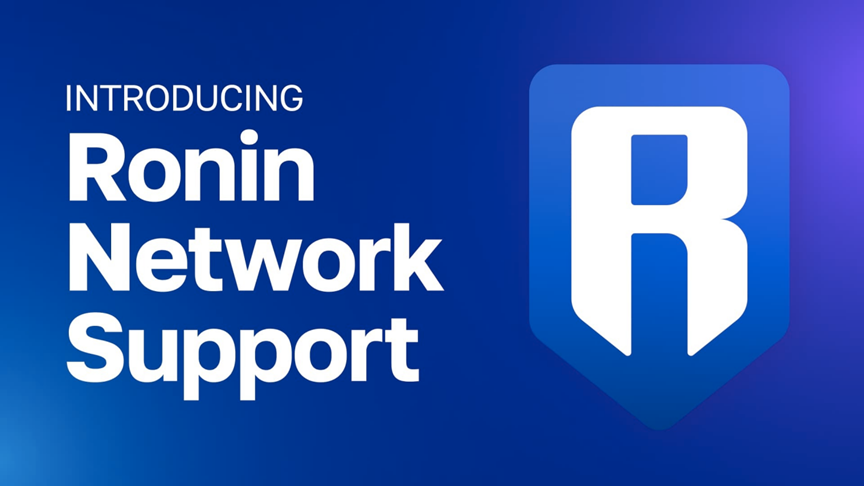
From Axie Infinity to Ronin Network
Ronin was developed by the game studio Sky Mavis, which focuses on technology, specifically by Jeffrey Zirlin, a Yale University graduate who worked at Sky Mavis for more than four years, and blockchain expert Alexander Leonard Larsen, who is also one of the founders of Axie Infinity.
Axie Infinity was the leading chain game that created a frenzy in the GameFi sector during the last bull market. At its peak, its monthly revenue reached $300 million, and its daily turnover once surpassed popular games such as Honor of Kings, giving rise to large game guilds like YGG. The success of Axie Infinity attracted a large number of game enthusiasts and developers to enter the Web3 game field, and successfully shaped today's GameFi track. However, with the increasing number of players, the slow settlement and high gas costs of Ethereum gradually raised the entry costs for players. With the decrease in new users and the entire market entering a bear market, Axie Infinity also fell into a death spiral.
To address Axie Infinity's dilemma, Ronin, a long-term expansion solution designed specifically for Axie Infinity, was born. Ronin is a concept proposed by Sky Mavis, the creator of Axie Infinity. Before the creation of Ronin, Sky Mavis had collaborated with the Loom Network. The Loom Network and its developers aimed to optimize the network to make it an enterprise-level solution rather than just a user-friendly application. The Sky Mavis team was not satisfied with this move and subsequently decided to end the collaboration and develop their own blockchain—Ronin Network.
As an EVM-compatible chain designed specifically for games, unlike previous Ethereum sidechains, Ronin aims to completely solve key issues in games such as high Ethereum gas fees and slow transaction speeds, providing players with a smoother and more seamless gaming experience. Currently, Ronin has demonstrated its huge potential in the NFT trading market, processing over $4 billion in transactions and attracting millions of daily active users.
The year 2023 was extremely important for Ronin. In January, Ronin released the desktop game aggregation platform Mavis Hub 2, in March it launched RON staking, in April it switched to the delegated proof-of-stake (DPoS) mechanism, and upgraded the functionality of Ronin Wallet, in May it launched the NFT market Mavis Market (and integrated Ronin Wallet), in September the chain game project Pixels migrated from the Polygon network to the Ronin network (also indicating further expansion of the Ronin partner program), in October it announced the launch of the Lucas (v2.6.2) upgrade and the Shillin hard fork on its mainnet, in November it reached a partnership with the South Korean game production company ACT Games, and ACT Games plans to migrate all its games to the Ronin network. In December, it reached partnerships with globally renowned game studios Foonie Magus, Directive Games, Bali Games, Tribes Studio, and Bowled.io, further expanding Ronin's game ecosystem.
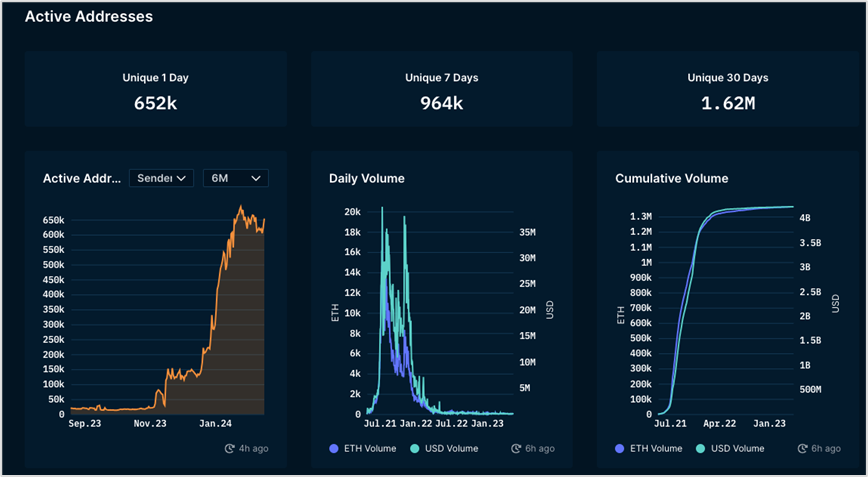
Image: Statistics of active addresses on Ronin
The steady development of Ronin Network has won the trust of market investors, especially thanks to its close cooperation with Axie Infinity. As a huge traffic pool, Axie Infinity provided Ronin with initial traffic and user base, and Ronin's market share in the chain game market once surpassed BNB Chain, ranking first, with a stable daily active address number of over 600,000. This traffic support has also enabled Ronin's native token RON to achieve an increase of over 800% in the past three months. As of now, the price of the RON token is $3.18, basically returning to the high point of the last bull market. This achievement further proves Ronin's competitiveness in the market and the confidence of investors in it.

Image: Market share of Ronin in the chain game market
Working Principle and Advantages of Ronin Network
Ronin Network is an innovative blockchain platform based on the Delegated Proof of Stake (DPoS) consensus mechanism, aiming to provide a highly scalable environment for game players and developers. By adopting advanced technology and economic models, Ronin Network has successfully addressed the scalability and high transaction costs of the Ethereum network. The working principle and technical advantages of Ronin Network will be detailed below.
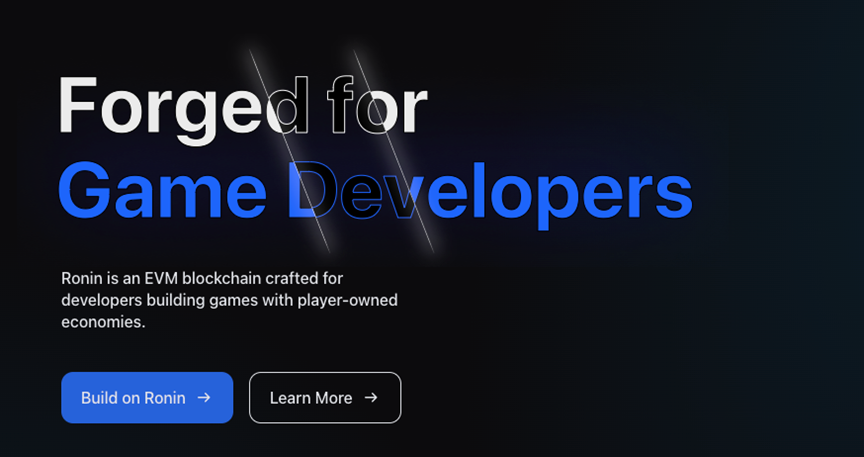
Sidechain Architecture
A sidechain is another independent blockchain parallel to the main chain. Compared to other networks, sidechains are easier to develop and can be optimized for specific scenarios. As an Ethereum sidechain, Ronin has its own independent block generation mechanism, consensus algorithm, etc., and can achieve asset interoperability with the Ethereum mainnet through bridging. This sidechain architecture allows Ronin to focus more on optimizing game scenarios while maintaining connectivity with the Ethereum ecosystem. Through the Ronin bridge, users can transfer assets such as ETH and ERC20 from the Ethereum mainnet to Ronin, and can also transfer native tokens and NFT assets issued on Ronin back to the Ethereum mainnet. This interoperable design allows game players to freely transfer assets between the two chains.
Hybrid Consensus Mechanism
Ronin Network adopts a hybrid consensus mechanism of Proof of Authority (PoA) and Delegated Proof of Stake (DPoS). Proof of Authority is an algorithm that uses identity as equity to achieve fast transactions. DPoS is a voting mechanism where token holders can delegate their voting rights to elected validators. This hybrid voting mechanism combines two different methods to maintain high transaction throughput and low confirmation time, while increasing decentralization and security.
In the Proof of Authority (PoA) consensus mechanism, Ronin Network is maintained and verified by a group of validation nodes designated by Sky Mavis. These validation nodes are trusted and responsible for packaging transactions into new blocks and adding them to the Ronin blockchain. The advantage of Proof of Authority is its high energy efficiency, as it does not require a large amount of computing power to verify transactions. This allows Ronin to achieve faster transaction speeds and lower transaction fees, thereby improving the gaming experience. However, Proof of Authority also has some potential issues, such as the risk of single point failure due to over-reliance on a few validation nodes. To increase the decentralization of the network, Ronin Network has introduced the Delegated Proof of Stake mechanism.
In the Delegated Proof of Stake mechanism, holders of RON tokens can delegate their voting rights to candidate validators. Validators with more delegated stakes have a greater chance of being selected to verify transactions and generate new blocks. By staking a certain amount of RON tokens as a candidate validator, users can participate in the network's validation and decision-making process, and have the opportunity to receive a portion of block rewards. This mechanism increases the decentralization of the network and effectively reduces the risk of single point failure.
Highly Scalable Blockchain Platform
Ronin Network is a highly scalable blockchain platform designed for game players and developers. It has the following technical advantages that enable it to handle large-scale transactions and provide outstanding performance:
High Throughput: Ronin Network can process up to 100,000 transactions per second, allowing it to meet the transaction demands generated by a large number of users and game interactions.
Low Latency: By adopting advanced technology and optimized network structure, Ronin Network ensures fast transaction confirmation and response, providing players with a seamless trading experience.
Low Transaction Fees: Compared to the high transaction fees of the Ethereum network, the transaction fees of Ronin Network are lower, allowing users to conduct transactions and interactions more economically.
Compatibility: Ronin Network is compatible with the Ethereum Virtual Machine (EVM), allowing existing Ethereum developers to easily migrate their applications and smart contracts to Ronin Network, expanding the scale of the developer community and project ecosystem.
RON Token Economic Model
RON is the native token of Ronin Network, with multiple functions and value. The economic model of the RON token aims to promote the development of the network and community participation, including the following aspects:
Transaction Fee Payment: RON is used to pay transaction fees on the Ronin network to maintain the efficient operation of the system.
Network Security and Staking: Holders can stake RON tokens to validators, participate in the network's security maintenance, and earn rewards through a reward mechanism. This mechanism incentivizes validators to maintain the security of the network, while also encouraging token holders to actively participate in network governance.
Participation in Governance Decisions: RON tokens grant holders voting rights in network governance, promoting community participation in important decisions and strengthening the transparency and consensus of the entire ecosystem.
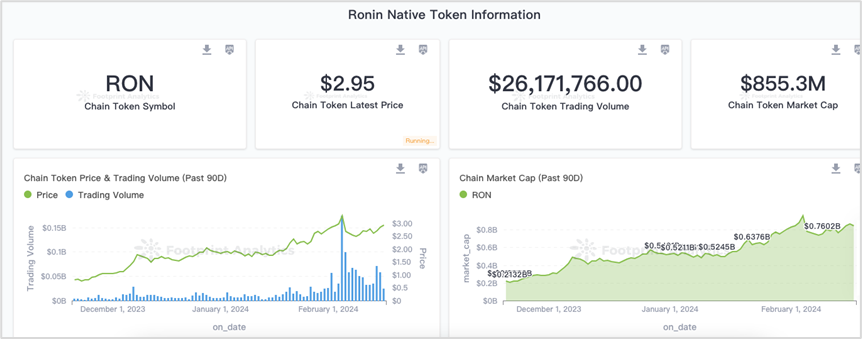
Image: Development of the Ronin token
In terms of token distribution, 30% of the token supply is owned by Sky Mavis, with a portion used for employee bonuses and shareholder token contracts. The community accounts for 30%, used for community incentives and development. The ecosystem fund accounts for 15% of the total supply, used to support initiatives to enhance Ronin Network. The remaining supply will be distributed through the staking reward mechanism.
Overall, Ronin Network has successfully built a highly scalable blockchain platform by adopting sidechain architecture, a hybrid consensus mechanism, and the RON token economic model. Token holders can earn rewards through delegated stake, participate in network governance decisions, and the use of the RON token also promotes the security and stability of the network. The technical advantages and principles of Ronin Network make it an ideal choice for the gaming industry and developers, providing a solid foundation for the development of the entire ecosystem.
Popular Chain Games on Ronin Network
As a blockchain platform dedicated to innovating games, Ronin Network has brought hope for the future of Web3 chain games to more players and game developers. Leveraging the early success of Axie, Ronin has partnered with several globally renowned game studios such as Directive Games, Bali Games, and Tribes Studio. Each studio is developing its own new chain game using Ronin. Additionally, with its outstanding performance, Ronin has attracted high-quality and mature chain game projects such as Pixels, further solidifying its position as a mainstream chain game platform.
Axie Infinity
Axie Infinity is the largest game on Ronin, allowing players to breed, raise, and battle fantasy creatures called Axies. The game pioneered the Play-to-Earn model in 2021 and remains one of the most popular web3 games globally.

Ronin was initially designed as an Ethereum sidechain specifically for the Axie ecosystem and has now become an important infrastructure for the Axie Infinity game. With the support of the Ronin network, Axie Infinity has undergone a new transformation. Recently, Axie introduced a new mechanism called AXP, allowing players to progress and upgrade Axies by winning in Origins and earning points. The introduction of AXP marks a shift for Axie from passive creatures to organic beings that can accumulate upgrades, and it also indicates that similar on-chain upgrade mechanisms may become popular in a wide range of NFT and gaming fields. AXP has realized the concept of Axie Core, injecting new momentum into Axie Infinity and the entire NFT ecosystem.
Pixels
Pixels is a social, casual, open-world Web3 game and platform launched in 2021. As a pixel-art metaverse farming game, Pixels recreates the atmosphere of classic 16-bit role-playing adventurers, allowing players to navigate in a pixel art world, interact with each other, cultivate land, play mini-games, and earn token rewards. Pixels also allows holders of selected NFT profile picture (PFP) collectibles to use their owned avatars in the game.

Pixels previously operated on Polygon and migrated to the Ronin network in 2023. According to Nansen's data, the number of active users on Ronin has significantly increased, from about 20,000 in November to the latest update of 665,000, with a large portion coming from Pixels. Pixels has also become another leading chain game on Ronin after Axie Infinity.
Currently, Pixels has integrated over 90 Web3 projects into its ecosystem. In terms of fundraising, as of February 8, 2024, Pixels has raised $4.8 million through three rounds of private token sales, led by Animoca Brands and PKO Investments, with participation from OpenSea and others. PIXEL is the native token of the Pixels project, and as the latest IEO project on Binance, PIXEL was listed on Binance at a price of $0.04. Its first-day increase exceeded 11,500%, and as of now, the price of PIXEL has surpassed $0.5.
Zoids Wild Arena
Zoids Wild Arena is a TCG (Trading Card Game) developed by the well-known South Korean game company ACT Games, where players can collect Zoids series mechanical creature cards and engage in 1v1 or 3v3 battles. In November 2023, the developer of Ronin, Sky Mavis, partnered with ACT Games, planning to bring all of ACT's games to the Ronin network. Zoids Wild Arena is the first game under ACT Games to migrate to Ronin.
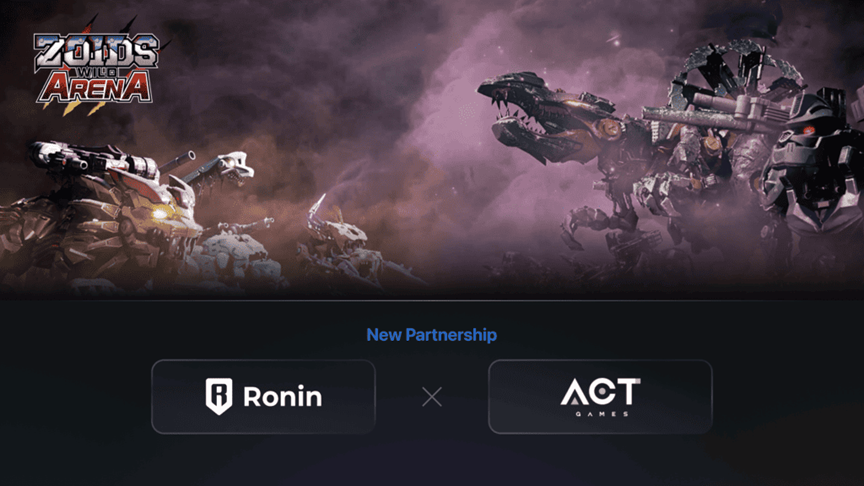
The migration of Zoids Wild Arena to the chain signifies that the cooperation between Sky Mavis and ACT Games has entered a substantive stage. For Ronin, the addition of traditional games is also a good opportunity. As confirmed by Trung Nguyen, CEO and co-founder of Sky Mavis in a statement, ACT Games has a good track record in expanding iconic IPs, reaching beyond audience groups, and increasing player engagement. He stated, "This partnership allows us to combine our Web3 knowledge and experience with nostalgic IPs supported by existing core fan bases."
免责声明:本文章仅代表作者个人观点,不代表本平台的立场和观点。本文章仅供信息分享,不构成对任何人的任何投资建议。用户与作者之间的任何争议,与本平台无关。如网页中刊载的文章或图片涉及侵权,请提供相关的权利证明和身份证明发送邮件到support@aicoin.com,本平台相关工作人员将会进行核查。




